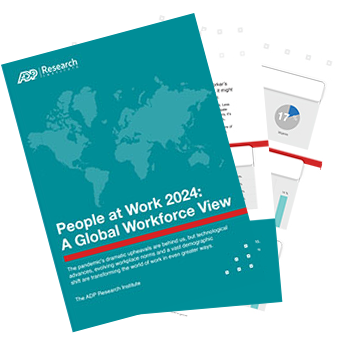A unique insight into the world of flexible working for HR leaders, from the workers themselves
Arguably, the greatest change to the workplace over the last few years has centred on flexible working arrangements. The pandemic turned the potential of working remotely into a practical and necessary reality for millions of people worldwide.
Flexible working is here to stay. But is the ‘new normal’ exactly what it was back in the spring of 2022? Our research suggests otherwise.
In our report, People at Work 2024: A Global Workforce View, we discovered that people’s expectations of flexible working have changed considerably since the pandemic, and several factors influence who benefits from its provision.
ADP Research
People at Work 2024: A Global Workforce View
One of the largest international studies of its kind, canvassing the views of over 34,000 workers in 18 countries, our research provides HR leaders with unique insights into the employee experience — people’s attitudes, aspirations, wants and needs.


Flexible working among staff’s top priorities
When we asked workers globally about their top job priorities, the results were predictable: salary (55%) and job security (46%) ranked highest, followed by career advancement (34%) and job enjoyment (29%).
Following on from these big hitters, flexibility also emerged as key. Specifically, 26% valued 'flexibility of hours' and 15% valued 'flexibility of location' as the most important job factors, highlighting that autonomy over work schedule matters nearly twice as much to employees as the location of their work.
In addition, around one in seven (15%) workers say the main reason they have a second income is precisely to help them achieve greater flexibility across their work and home lives.
HR leaders will also be interested to see that almost one in five workers (19%) feels so strongly about the need for flexible working that they cite the lack of such opportunities as the main reason they’re dissatisfied with their current employment.
Flexible working increasingly finding favour
Yet our research shows that companies worldwide have become more flexible, not less so, regarding when and where staff do their jobs.
A significant 38% of employees report that their companies have eased up on workplace location rules over the past year, closely matched by a 37% increase in flexibility around working hours. This trend holds true across all four regions analysed in our study.
Employers stand to gain significantly from a more relaxed approach to flexibility when it comes to employee engagement. It's clear that workers highly value the increased freedom. Last year, 54% of respondents expressed satisfaction with their flexibility of hours and location, a number that has now surged to 67%.
Even more notably, a substantial 68% of the global workforce feels confident and empowered to take full advantage of flexible working arrangements.
That said, our research shows there are several factors influencing the extent of flexible working that employers support. These include:
- Workers’ age
While 28% of employees worldwide have complete flexibility to choose the location they work from, the youngest generation is most likely to enjoy this benefit.
Nearly a third (32%) of Gen Z employees (aged 18-24) can choose to work from home or company premises, compared to 27% of those aged 35-44 and just 16% of the oldest workers (those aged 55+). And while 28% of the global working population say they have to work from the workplace every day, that rises to 55% for those in the oldest age group.
There’s a similar pattern when it comes to flexibility of hours, with 41% of Gen Z reporting that their employer has eased up on this over the last year. However, only 16% of the oldest employees say the same. Given that more workers aged 55+ prize the freedom to choose working hours than their younger counterparts, this should sound alarm bells for HR policymakers.
- The country where people work
Our results reveal a huge variation in flexible working availability across the 18 countries in our study. For example, contrast the 45% of workers in India who report complete flexibility to choose whether to work from the workplace or from home with the 32% in the US, 22% in Australia and just 16% in both France and Italy who say the same.
The disparity continues when it comes to the countries where workers have noticed employers easing up on working location and hours. Forty-one percent of workers in China say their employers have become more flexible with working location and hours in the past year. In comparison, only 34% of employees in Brazil, 24% in the UK, and 17% in Japan have noticed similar changes from their employers.
- The industry workers belong to
Perhaps unsurprisingly, there’s wide variation in flexible working opportunities across sectors. For instance, in Spain, the percentage of employees with complete flexibility in choosing their workplace varies greatly depending on the industry. While 31% of workers in the IT & telecoms sector enjoy this benefit, only 13% in retail, catering & leisure do.
Globally, while half (50%) of workers in the IT & telecoms sector have seen their employers become more relaxed about whether they work from home, far fewer (44%) in professional services and the travel & transport sector (21%) report the same.
- Parental status (and the age of any children)
Over half (51%) of parents with infants say their employer has become more flexible about their work location over the last year. But just 21% of parents with adult children (aged 18+) and only a third (33%) of workers without children are granted the same level of flexibility.
- Full or part-time status
Part-time workers are less likely to say their employers have become more flexible about working hours and location over the last 12 months than their full-time counterparts. In fact, part-time employees trail their full-time colleagues by around seven percentage points in both flexibility of hours and location.
This might not be surprising, but it does spotlight the inconsistent employee experience among different categories of workers.
- Seniority
People at Work 2024: A Global Workforce View reveals a worldwide phenomenon — the more senior an employee is in the organisation, the more likely they are to have ‘complete flexibility’ as to where they work. Here’s how the disparities stack up:

Should this issue be a red flag for HR leaders worldwide?
What factors don’t affect flexible working availability?
Our findings show there are certain characteristics of employees and employers that don’t seem to play a role in the flexible working benefits staff enjoy. These include:
- Gender
Globally, men and women (37%) are equally likely to report that their employer has become more relaxed about the hours they work during the last year. Slightly more women (40%) than men (36%) say their employer is more relaxed about their work location.
- Company size
It seems that an organisation’s size has little impact on whether its employees enjoy more or less flexibility in terms of hours or location. In fact, there’s no guarantee that working for a larger company will bring greater flexibility.
From small firms (with 1-49 employees) and mid-sized businesses to global enterprises with a thousand workers or more, well over half of people say there’s been no change in their employer’s attitude to where (55%) or when (57%) they work.
How to power up the positives of flexible working
As an HR leader, you’ll know that offering more flexible and hybrid working options is a proven way to attract and retain talent. Yet, as HR professionals, you have many factors to consider while developing your flexible working policies amid changing workforce dynamics.
A new issue your company may have to contend with going forward is the evolving regulatory landscape. More and more governments around the world are legislating to codify the rights and responsibilities of employers and employees regarding flexible working.
Return to office (RTO) policies — a work in progress?
Legal challenges to RTO mandates are currently being undertaken in tribunals and courts, with experts in law and HR predicting more to come.
A powerful first step on your journey is being aware of the equality of the employee experience your business and others in similar circumstances offer workers. You can start by familiarising yourself with the findings of our study, People at Work 2024: A Global Workforce View.


